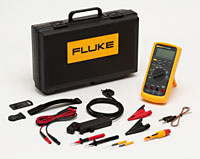Multimeters
 Multimeters are a vital addition to any DIY mechanic's tool kit. Many faults reported by the vehicle systems turn out to be errors from
mis-reporting sensors, and there is no true mechanical problem. A good Multimeter will be able to identify damaged wiring and short circuits, Earthing problems, faulty components
and also give a visual indication of sensor values that may help in tracking down the cause of a Fault
Multimeters are a vital addition to any DIY mechanic's tool kit. Many faults reported by the vehicle systems turn out to be errors from
mis-reporting sensors, and there is no true mechanical problem. A good Multimeter will be able to identify damaged wiring and short circuits, Earthing problems, faulty components
and also give a visual indication of sensor values that may help in tracking down the cause of a Fault
When choosing a Multimeter, always look for vehicle specific versions. These will have a high Impedance, which will
be safer to use on sensitive electronics, and also will be more accurate. Old low impedance meters will allow a large current flow whilst taking readings, which can
affect the accuracy of the measurement, and also draw enough current to damage components. Fluke are highly recommended, and have a large range for different applications.
You should look for Voltage, Current and Resistance measurement and Continuity and a minimum. Additional features such as Dwell, Duty cycle, Value Holds
and backlights are handy additions for deeper study.
Autoranging meters are available which will chose the range automatically for a given measurement. For Manual ranging tools, select the range carefully. If you are testing DC voltage, choose the largest
range first, often 0-200v for a small meter, and move down through the ranges until you are at a useful range. 0-20v DC will cover most vehicle
functions. Do not use a Multimeter on the Ignition system unless it is capable of doing so. The high voltages generated can quickly turn your new toy into
a smoking lump of plastic.
A great use of a Multimeter is when trying to track down Battery drains. Firstly, be aware that there is a limit for Current flow for the Meter, often around 10 Amps, so
check the rating and avoid and large consumers that may draw more power. A fuse is often installed as protection, but the best protection is prevention.
If you connect the Multimeter in series with the main battery lead, you will get a measurement of the Current flowing through the car. Large draws will
be visible, and removing fuses one by one will identify which circuit is drawing the power. Do not attempt the start the vehicle in this condition, or operate any components as you
will exceed the rated Current, but you will now be able to narrow down your search to a number of smaller components, and solve the problem.
Earthing problems can be tracked down by connecting the Meter with the -ve terminal of the battery, and checking other earthed
components for a raised Ground plane, where an insufficient ground lead, or malfunctioning component leaks electrical power
and lowers the Potential difference. For example, a poorly earthed sensor may report lower than expected values, as the difference between +ve and -ve has been decreased from
the -ve ground plane being at a higher voltage